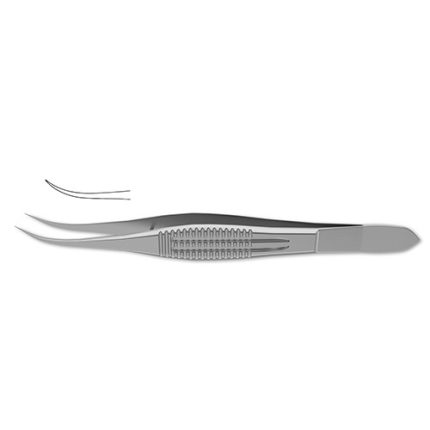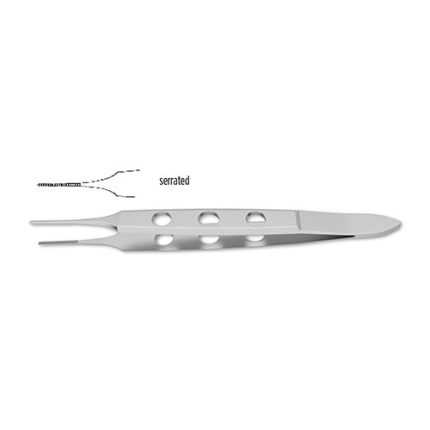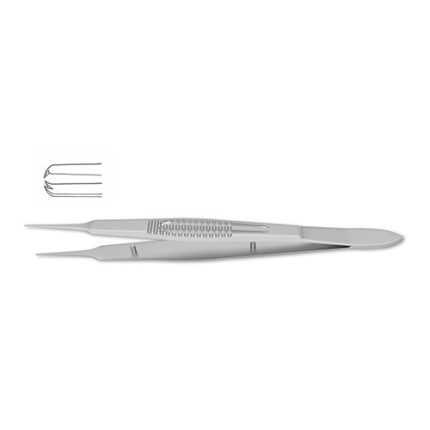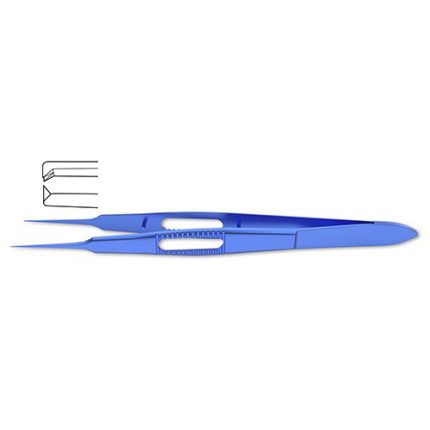| Name | Foerster Eye Forceps |
| Lead Time | Lead time advised within 48 hours of order placement. |
| Competitor | ;604260;60-4260;6042-60;PM4725;PM-4725;18-798;P4725;18798;6042-61;6042-63;PM4726;PM-4726;RS5101;RS-5101;6042-64;6042-60_6042-64; |
| Specialty | Ophthalmology-Stainless Forceps |
| Material Finish | Stainless Steel |
| Grade | Premium Operating Room |
| Units of Measurement | Each |
| Manufacturer | Steknor International |
| Sterility | Non-Sterile |
| Usage | Reusable |
Foerster Eye Forceps
octagonal grip, 0.5 mm width, 3-3/4″ (9.5 cm) Foerster Eye Forceps are a unique tool for ophthalmologic surgeries. The forceps come available with serrated tips designed to handle sterile dressing material, or 1×2 teeth manufactured to firmly grip tissue. The unique octagonal grip provides differential traction for the surgeon during the procedure, allowing for greater manipulation of the instrument. Finally, both a straight and curved profile is available with the forceps depending on surgical preference.
SKU:
NHS-05-1115
Category: Forceps
Description
Reviews (0)
Be the first to review “Foerster Eye Forceps” Cancel reply
Shipping & Delivery
Related products
Arruga Capsule Forceps
Botvin Iris Forceps
bayonet-shaped, cross-serrated, 3" (7.5 cm) Botvin Iris Forceps are a useful tool in ophthalmologic procedures involving repair of the iris following trauma. The forceps are designed to handle the long needle necessary for iris suturing, commonly used with 10-0 polypropelene or 4-0 silk sutures. The bayonet style design is meant to minimize surgical obstruction during the operation.
Bishop-Harmon Tissue Forceps
very delicate narrow, smooth jaws, angled 45 degrees, 4-1/2" (11.5 cm) Bishop-Harmon Tissue Forceps are a commonly used tool in a variety of ophthalmologic procedures. The forceps are designed for grasping delicate tissue in a small surgical field. Three finger holes on the handle allow the surgeon to adjust his or her grip during the procedure as desired. The forceps are available in straight or curved styles depending on surgical preference.
Bergh Cilia Forceps
cross-serrated tips, delicate, 3-3/8" (8.6 cm) Bergh Cilia Forceps are a multipurpose instrument for ophthalmologic procedures involving the eyelid. The forceps feature a serrated jaw that can be used for removing the cilia for trichiasis or management of blepharitis marginalis. The heavy spring pattern gives the surgeon increased power during the operation.
Castroviejo Suture Forceps – Angled Shaft
wide handle, 1x2 teeth on angled shaft, w/ platform, 4-1/8" (10.5 cm)Castroviejo Suturing Forceps are a multipurpose tool for a variety of ophthalmologic procedures. The heavy set teeth ensure the firm grasp of tissue or suturing equipment without slippage. The forceps are available with a tying platform, designed to grasp both the tissue and suturing equipment without changing instruments. Three different teeth sizes are available on the forceps depending on surgical preference.
Castroviejo Fixation Forceps
wide handle, w/ out platform, 1x2 teeth, 4-1/8" (10.5 cm)Castroviejo Fixation Forceps are a useful tool in a variety of ophthalmologic procedures. The toothed design aids in the grasping and handling of the conjunctiva and episcleral tissue. In addition, the forceps may be used to hold the globe in place, aiding in other surgical maneuvers. Two different tooth sizes are available on the forceps depending on surgical preference.
Clayman Iol Forceps
angled 70 degrees, 3.0 mm tips, 4-3/4" (12.1 cm)Clayman IOL Folding Forceps are a unique tool used in artificial lens implantation techniques. The forceps are designed to fold the IOL either horizontally or longitudinally to allow for easier implantation. The rounded soft curve of the forceps aids in gripping the IOL with minimal damage or alteration. The angled tips provide increased visibility during the procedure.
Berens Muscle Clamp
w/ slide lock, 4" (10.0 cm) Berens Muscle Clamp is a unique tool designed to handle the muscle insertions of the eye. The clamp features 13.5 mm blades, wide enough to handle the extraocular and levator muscles. The teeth on the bottom blades are specially designed to avoid slipping and hold the muscle for further manipulation.













Reviews
There are no reviews yet.